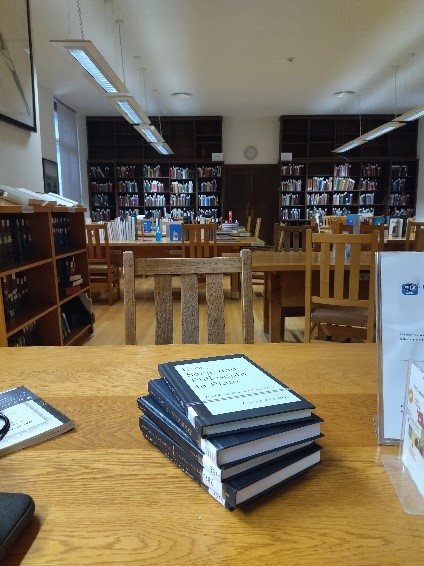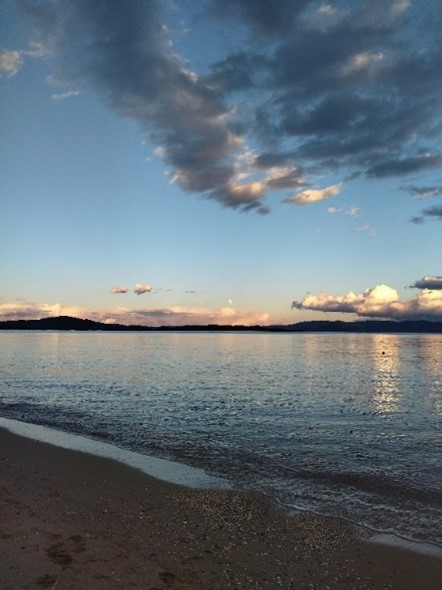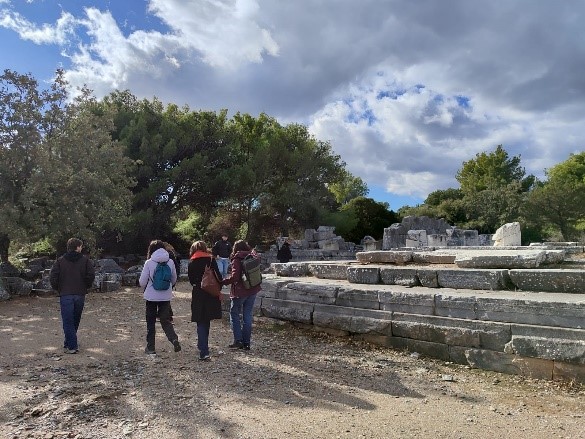By Julia Rey-Conde, ReMA student in Philosophy, Utrecht University
Right across the Acropolis, Filopappos hill offers a beautiful view of both the ancient and modern cities of Athens. Whilst taking the picture I was standing beside the ruins of the city’s first democratic assembly. It was my first day off since I arrived in Athens to conduct research for my master’s thesis. Plato’s attack on poetry had so far occupied all my attention. I could now see what remains of the world I read so much about in the Republic.
In the Republic’s opening scene, Socrates is walking down a hill during sunset hours. Hills were the first thing that stroke my eye through the airplane window, right before landing in Athens. Somehow unknowingly, I was expecting the philosopher’s city to be “a rough and rocky place”, as described in one of the books covering the walls of the Netherlands Institute’s library.
NIA’s director, Dr. Ann Brysbaert, had positively responded to my application in mid-July. I was accepted for a monthly stay at the Netherlands Institute in Athens to develop the last chapter of my master’s thesis. Around that time a year ago I decided to specialise in Ancient Greek philosophy. It seemed like a novelty after a bachelor’s and a master’s where philosophy, but not Antiquity, constituted the main focus.
Yet I remember, looking back at my student years, my first research experience being about cynic philosophy. Amidst the literature I got acquainted with, I came across a book on archaic Greek lyric poetry. It was the first book I reviewed for an academic journal. Then I moved to Utrecht for my master’s, where ancient philosophy is prominent in the philosophy faculty. I had the chance to learn ancient Greek and to enrol in several courses about Classic and Hellenistic philosophy. After a year focusing on Plato, Athens seemed the place to be for completing my master’s thesis. I am thus very grateful to both NIA and my thesis supervisor, Dr. Mauro Bonazzi, for providing me with this opportunity.
Studying at the libraries of Archaeological Institutes
The network of Archaeological Institutes in Athens supplied me with the material I needed to conduct my research. Each institute includes an academic library where journals and books of difficult access can be found. I was surprised to handle most of the books I have been consulting online. No need to say, LOEB bilingual editions of Plato’s dialogues can be found in all of them. Although Michael Frede’s fond in the British Library was not yet open to the public, I profit mostly from the Blegen Library at the American Institute.


The Blegen Library hosts an impressive collection of ancient philosophy. Both classic and up-to-date publications in the field can be found. Although my thesis concerns Plato’s most famous dialogue, the Republic, I engage with a topic that has not been much discussed: the role of poetry for the moral education of desire. In the Blegen Library I could find titles concerning poetry’s connection with desire and beauty I had not reach online.


In the British School library I could also profit from unexpected findings. I stumbled upon a verse translation of Socrates’ speeches in the Phaedrus. His second speech, uttered as a palinode to restore eros, is well know for both its literary form and its complexity. I had been reading it for some time without getting any clear understanding of the topic. I found this verse translation to render the speech in both an inspiring and explanatory manner.
The Nordic Library and the library at the Italian Archaeological School had likewise supported my research. They are at walking distance from the Netherlands Institute, around the Acropolis’ boulevard. To both the staff and the people I have met there I am very thankful, for their generosity and amusing company.
Sunday trips
On Sundays we travel –such was the mood of my new group of friends. I have met them through the Blegen Library, where they would also study for their master’s thesis in classics, archaeology, or epigraphy. Every Sunday morning for three consecutive weeks we would rent a car in Avance, a rental close to Makrygianni, to visit some historical site in Greece. We began with Nauplia, a beautiful town in the Peloponnese not far away from Athens. We walked through the seaside until an empty Arvanitia Beach. As the beach is right beneath the acropolis, we hiked the hill and walked through the ruins of the old city of Nauplia.


Ancient Delphi was our next destination. Everyone felt excited to explore what remains of the most honoured oracle in Antiquity. From the entrance to the site, in the slopes of Mont Parnassus, the Sacred Way escalates the mountain until Apollo’s Temple.
The ruins of the Temple of Apollo announce its magnificent size. Inside the temple we could see the large ramp that transported the pilgrim to the Pythia, Apollo’s mouthpiece. The Pythia delivered the deity’s oracles, such as “know yourself” or “nothing in excess”, in a dark cave excavated underground.
We walked our way outside Apollo’s domains to visit the Sanctuary of Athena Pronaia. Likewise located in the slopes of Mount Parnassos, it offers an astounding view of the landscape. I could not resist taking a picture of the much appreciated tholos, that I have seen so many times in the cover of my lonely planet guide to Greece.
Our last trip took us to the Sanctuary of Ramnous. Located in the north of Attica, Ramnous was unknow to all of us except from Marianna, a friend whose Master’s thesis revolved around this Ancient site. She recounted to us the stories of the two temples in Ramnous. The temple of Nemesis was consacrated to the deity of retribution. Although nemesis is commonly rendered by the English term revenge, it lacked a bad connotation. Compensation for hybris, the excess commited by mortals, was Nemesis’ chore.
Standing right beside we could see the ruins of a second temple dedicated to Themis, the goddess of Justice. The proximity of both cults, Nemesis and Themis, reminded me of Anixamander’s account of cosmic justice. “Whence things have their origination, thence must they also perish, according to necessity; for they must pay retribution and be judged for their injustices, according to the order of time.”[1]
Right before sunset we arrived to Marathon Beach, where we were almost alone whilst crossing the sandy land.


Goodbye Athens
I conclude this monthly stay thinking about all I left undone, all the things I can still learn and see. I hope I will be back in Athens one day to pursue this trip that started at NIA. Until then, I am contented to keep all these memories and I am sure they will be a source of inspiration in the time to come.
[1] Translation compiled by Heidegger in The beginning of Western Philosophy (translated by Richard Rojcewicz, Indianapolis, 2015).





